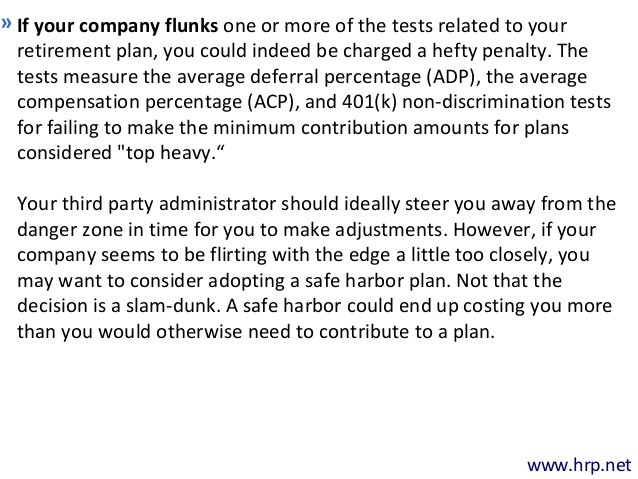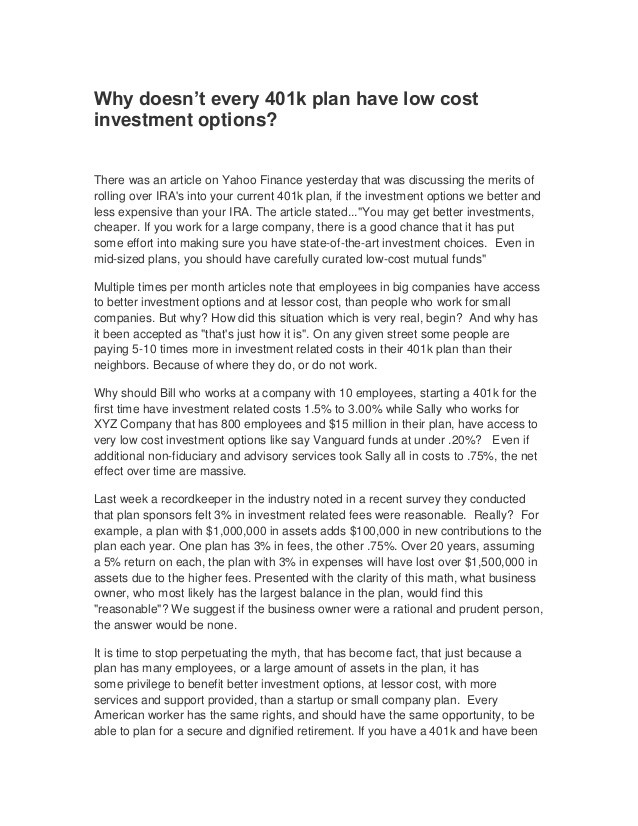Why Investment Choices In Your 401(k) Might Change
Post on: 11 Апрель, 2015 No Comment

Have the investment offerings in your 401(k) plan changed recently? If not, they might soon. That’s because as plan sponsors scrutinize the cost of 401(k) plan investment options more closely, there is a growing trend away from higher- cost retail mutual funds to lower-cost “institutional” versions of these funds and to low-cost index funds. According to a recent survey by Hewitt Associates. a human resources consulting company, 74% of employers are making efforts to reduce 401(k) plan expenses, up from 57% in 2007. Moreover, according to the Hewitt study, 51% of employers are moving to lower-cost investment options.
To understand what’s going on, a history lesson is helpful. When 401(k) plans were first introduced in the 1980s, plan design was largely a function of Department of Labor regulations, which required that a plan have at least three diversified investment alternatives. Typical plans in those days featured only about five or six investment options.
But in the 1990s, as companies began scaling back traditional pensions and 401(k)s became central to workers’ retirement security, plans started providing many more investment options. The thinking was this would enhance plan participants’ ability to meet their retirement savings goals and better diversify their portfolio to mitigate risk.
In this stage of 401(k) plan design, sponsors turned to the mutual fund industry to supply the investment vehicles to augment existing plans. A typical design would retain a core of investment options, supplemented by an expanded lineup of retail mutual funds. Many plans grew to include dozens, and in some cases, hundreds of investment choices. This new structure was largely praised by participants, as 401(k) plans were taking on an ever increasing role in funding their retirement income needs.
There is, however, a problem with using retail mutual fund shares–they typically have the same cost structure, known as the expense ratio, within a 401(k) plan as they do when offered to retail investors. Why is the expense ratio of a mutual fund an issue? Some costs are related to the management of the fund to pay for investment research, professional management and trading costs for the underlying securities. When a fund exhibits superior performance relative to its peers and its benchmarks, those costs are justified.
But other costs can include marketing the fund to the public to help a fund company stand out from the competition. In other words, retail fund shareholders are paying not just for the management of their money, but also for all of those TV commercials. With retail mutual fund shares in a 401(k) plan, the plan participant may still pay for these marketing costs (known as a 12b-1 fee) in addition to the management fees. To critics, marketing and advertising costs for retail funds offered to the general investing public make sense within reasonable limits but do not make much sense when they are being tacked on to investment options within a 401(k) plan.
After all, plan participants are not shopping among thousands of retail funds, they are merely choosing between a few dozen options within their 401(k) plan. These marketing and advertising costs associated with retail funds within 401(k) plans essentially drain money away from retirement savers. So now, we’ve moved into a new stage, where 401(k) plans are evolving yet again as sponsors assume a fiduciary duty to participants to keep costs modest.
My firm directs over $300 million for our clients within their individual 401(k) and 403(b) accounts, so we are regularly analyzing investment options within several different plans. One we follow closely–the plan at Ford Motor –has recently made some changes in its investment menu that (through May of this year) have reduced the average expense ratio for investment options by more than 20%. “Our goal is to deliver a highly valued, competitive 401(k) plan,” says Rick Popp, director of Employee Benefits at Ford. “We want plan participants to have the tools that help them build a diversified portfolio in order to meet their retirement savings goals within a framework that strives to provide cost efficiency,” he adds.

While expense ratio and other mutual fund internal costs are important, the investment recommendations we make for clients are primarily driven by expected total return, portfolio diversification attributes, and risk reduction potential. When a plan sponsor adds a lower-cost investment option that demonstrates superior performance compared to the fund it replaced, we view it as a “win-win” for plan participants.
Consider the General Motors 401(k) plan, where the cost of investment options has also been seriously addressed. In a 2007 overhaul of the plan, several funds were replaced with investment options that have lower internal expense ratios. One example is Fidelity Inflation-Protected Bond with an expense ratio of 45 basis points (0.45%). This retail mutual fund was replaced with an institutional fund–PIMCO Real Return Strategy–of similar objective, but lower expense ratio. (An institutional fund isn’t offered directly to retail investors.) In this case, PIMCO Real Return Strategy has delivered a higher total return to investors than Fidelity Inflation-Protected Bond since its introduction into the plan in July 2007. Therefore, thus far this change has resulted in a better performing investment option, with a lower internal expense ratio. (Of course, past performance is no guarantee of future results.)
Plan sponsors have also been working to reduce costs for another investment vehicle within 401(k) plans. Target-date funds, sometimes referred to as lifecycle funds, are designed to regularly reallocate their asset mix based on a future target date. This reallocation is aimed at reducing the portfolio’s risk as retirement age draws closer. At fund companies such as T. Rowe Price, Fidelity and American Funds, retail target-date funds typically hold a number of the fund family’s retail mutual funds in their asset mix. The General Motors plan formerly offered Fidelity Freedom Funds, but now offers lower-cost (institutional) Pyramis Active Lifecycle Funds. Pyramis Active Lifecycle 2050, for instance, has a significantly lower internal expense ratio than Fidelity Freedom 2050, while (so far) outperforming Freedom 2050 on a total return basis since its inception in July 2007. (Again, past performance is no guarantee of future results.)
More 401(k) participants will likely see their plan’s investment menu change in coming years, as other employers look to bring down investment option costs. While change can be unsettling (and requires the participant to pay attention to his choices), it is a positive trend when plan participants can achieve a particular portfolio objective with superior returns, while paying less of their returns in fees.
David Kudla is CEO and chief investment strategist of Mainstay Capital Management, a fee-only, independent, registered investment advisor. More information about his firm can be found at www.mainstaycapital.com .














